However I still visit the remaining gardens once or twice a week.
On Sunday afternoon, I was there when a flock of European bee-eater rested for half an hour.
European bee-eater
The Riyadh area including this site is odd because I see more blue-cheeked blue-eater in autumn and more European bee-eater there in spring. In my opinion their routes must be different depending on the season.
three bee-eater
Until Sunday evening I had thought that passage birds had been really thin on my walk this spring because of the diminished size of the green area.
resident little green bee-eater
The number of sightings of the resident little green bee-eater in the area have decreased too.
hoopoe
Turkestan shrike
Telling apart the two red tailed shrikes can be difficult. A bird seen at the university farm a week ago was particularly tricky. I believe it is a male Turkestan shrike but its underparts are not as white as average and its supercilium is weaker. Nevertheless its upper parts are quite dark and its crown is distinctly browner than its mantle. Also foxy-red as opposed to orange-red tails are more common in Turkestan shrike. Of course it could easily be an intergrade which is not rare.
willow warbler
Only a solitary warbler has been seen in my visits to the old farm since the beginning of April. This was a willow warbler. The number of warblers is possibly the biggest single difference from previous passage seasons.
The only other passage bird seen on the remnants of the farm was a common quail which I accidentally flushed and failed to relocate.
white spectacled bulbul
Both white spectacled bulbul and white eared bulbul are hanging on in the more confined apace.
Indian silverbill
The Indian silverbill are roaming and found on the farm only occasionally now. All the silverbills I see in any location near Riyadh look worse for wear at the moment. I am not sure whether this is just moulting or whether it is the heat taking its toil.
crested lark
Spare a thought for the urban crested lark in the area which is now a major building site. Surely they can't take much more and will relocate.










No comments:
Post a Comment